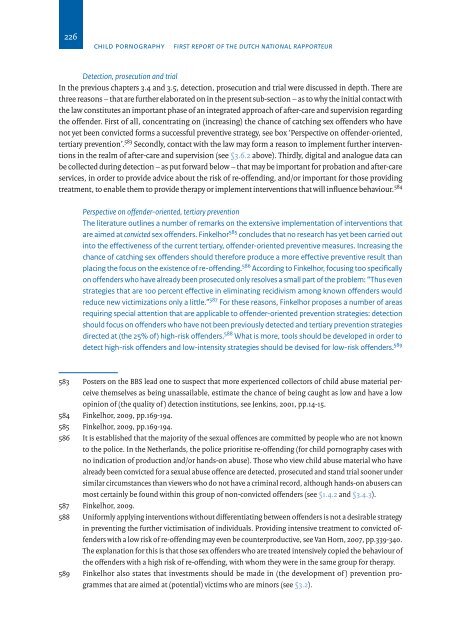Child Pornography - Home | National Rapporteur on Trafficking in ...
Child Pornography - Home | National Rapporteur on Trafficking in ...
Child Pornography - Home | National Rapporteur on Trafficking in ...
Create successful ePaper yourself
Turn your PDF publications into a flip-book with our unique Google optimized e-Paper software.
226<br />
<str<strong>on</strong>g>Child</str<strong>on</strong>g> PornograPhy First report oF the Dutch NatioNal rapporteur<br />
Detecti<strong>on</strong>, prosecuti<strong>on</strong> and trial<br />
In the previous chapters 3.4 and 3.5, detecti<strong>on</strong>, prosecuti<strong>on</strong> and trial were discussed <strong>in</strong> depth. There are<br />
three reas<strong>on</strong>s – that are further elaborated <strong>on</strong> <strong>in</strong> the present sub-secti<strong>on</strong> – as to why the <strong>in</strong>itial c<strong>on</strong>tact with<br />
the law c<strong>on</strong>stitutes an important phase of an <strong>in</strong>tegrated approach of after-care and supervisi<strong>on</strong> regard<strong>in</strong>g<br />
the offender. First of all, c<strong>on</strong>centrat<strong>in</strong>g <strong>on</strong> (<strong>in</strong>creas<strong>in</strong>g) the chance of catch<strong>in</strong>g sex offenders who have<br />
not yet been c<strong>on</strong>victed forms a successful preventive strategy, see box ‘Perspective <strong>on</strong> offender-oriented,<br />
tertiary preventi<strong>on</strong>’. 583 Sec<strong>on</strong>dly, c<strong>on</strong>tact with the law may form a reas<strong>on</strong> to implement further <strong>in</strong>terventi<strong>on</strong>s<br />
<strong>in</strong> the realm of after-care and supervisi<strong>on</strong> (see §3.6.2 above). Thirdly, digital and analogue data can<br />
be collected dur<strong>in</strong>g detecti<strong>on</strong> – as put forward below – that may be important for probati<strong>on</strong> and after-care<br />
services, <strong>in</strong> order to provide advice about the risk of re-offend<strong>in</strong>g, and/or important for those provid<strong>in</strong>g<br />
treatment, to enable them to provide therapy or implement <strong>in</strong>terventi<strong>on</strong>s that will <strong>in</strong>fluence behaviour. 584<br />
Perspective <strong>on</strong> offender-oriented, tertiary preventi<strong>on</strong><br />
The literature outl<strong>in</strong>es a number of remarks <strong>on</strong> the extensive implementati<strong>on</strong> of <strong>in</strong>terventi<strong>on</strong>s that<br />
are aimed at c<strong>on</strong>victed sex offenders. F<strong>in</strong>kelhor 585 c<strong>on</strong>cludes that no research has yet been carried out<br />
<strong>in</strong>to the effectiveness of the current tertiary, offender-oriented preventive measures. Increas<strong>in</strong>g the<br />
chance of catch<strong>in</strong>g sex offenders should therefore produce a more effective preventive result than<br />
plac<strong>in</strong>g the focus <strong>on</strong> the existence of re-offend<strong>in</strong>g. 586 Accord<strong>in</strong>g to F<strong>in</strong>kelhor, focus<strong>in</strong>g too specifically<br />
<strong>on</strong> offenders who have already been prosecuted <strong>on</strong>ly resolves a small part of the problem: “Thus even<br />
strategies that are 100 percent effective <strong>in</strong> elim<strong>in</strong>at<strong>in</strong>g recidivism am<strong>on</strong>g known offenders would<br />
reduce new victimizati<strong>on</strong>s <strong>on</strong>ly a little.” 587 For these reas<strong>on</strong>s, F<strong>in</strong>kelhor proposes a number of areas<br />
requir<strong>in</strong>g special attenti<strong>on</strong> that are applicable to offender-oriented preventi<strong>on</strong> strategies: detecti<strong>on</strong><br />
should focus <strong>on</strong> offenders who have not been previously detected and tertiary preventi<strong>on</strong> strategies<br />
directed at (the 25% of) high-risk offenders. 588 What is more, tools should be developed <strong>in</strong> order to<br />
detect high-risk offenders and low-<strong>in</strong>tensity strategies should be devised for low-risk offenders. 589<br />
583 Posters <strong>on</strong> the BBS lead <strong>on</strong>e to suspect that more experienced collectors of child abuse material perceive<br />
themselves as be<strong>in</strong>g unassailable, estimate the chance of be<strong>in</strong>g caught as low and have a low<br />
op<strong>in</strong>i<strong>on</strong> of (the quality of ) detecti<strong>on</strong> <strong>in</strong>stituti<strong>on</strong>s, see Jenk<strong>in</strong>s, 2001, pp.14-15.<br />
584 F<strong>in</strong>kelhor, 2009, pp.169-194.<br />
585 F<strong>in</strong>kelhor, 2009, pp.169-194.<br />
586 It is established that the majority of the sexual offences are committed by people who are not known<br />
to the police. In the Netherlands, the police prioritise re-offend<strong>in</strong>g (for child pornography cases with<br />
no <strong>in</strong>dicati<strong>on</strong> of producti<strong>on</strong> and/or hands-<strong>on</strong> abuse). Those who view child abuse material who have<br />
already been c<strong>on</strong>victed for a sexual abuse offence are detected, prosecuted and stand trial so<strong>on</strong>er under<br />
similar circumstances than viewers who do not have a crim<strong>in</strong>al record, although hands-<strong>on</strong> abusers can<br />
most certa<strong>in</strong>ly be found with<strong>in</strong> this group of n<strong>on</strong>-c<strong>on</strong>victed offenders (see §1.4.2 and §3.4.3).<br />
587 F<strong>in</strong>kelhor, 2009.<br />
588 Uniformly apply<strong>in</strong>g <strong>in</strong>terventi<strong>on</strong>s without differentiat<strong>in</strong>g between offenders is not a desirable strategy<br />
<strong>in</strong> prevent<strong>in</strong>g the further victimisati<strong>on</strong> of <strong>in</strong>dividuals. Provid<strong>in</strong>g <strong>in</strong>tensive treatment to c<strong>on</strong>victed offenders<br />
with a low risk of re-offend<strong>in</strong>g may even be counterproductive, see Van Horn, 2007, pp.339-340.<br />
The explanati<strong>on</strong> for this is that those sex offenders who are treated <strong>in</strong>tensively copied the behaviour of<br />
the offenders with a high risk of re-offend<strong>in</strong>g, with whom they were <strong>in</strong> the same group for therapy.<br />
589 F<strong>in</strong>kelhor also states that <strong>in</strong>vestments should be made <strong>in</strong> (the development of ) preventi<strong>on</strong> programmes<br />
that are aimed at (potential) victims who are m<strong>in</strong>ors (see §3.2).


